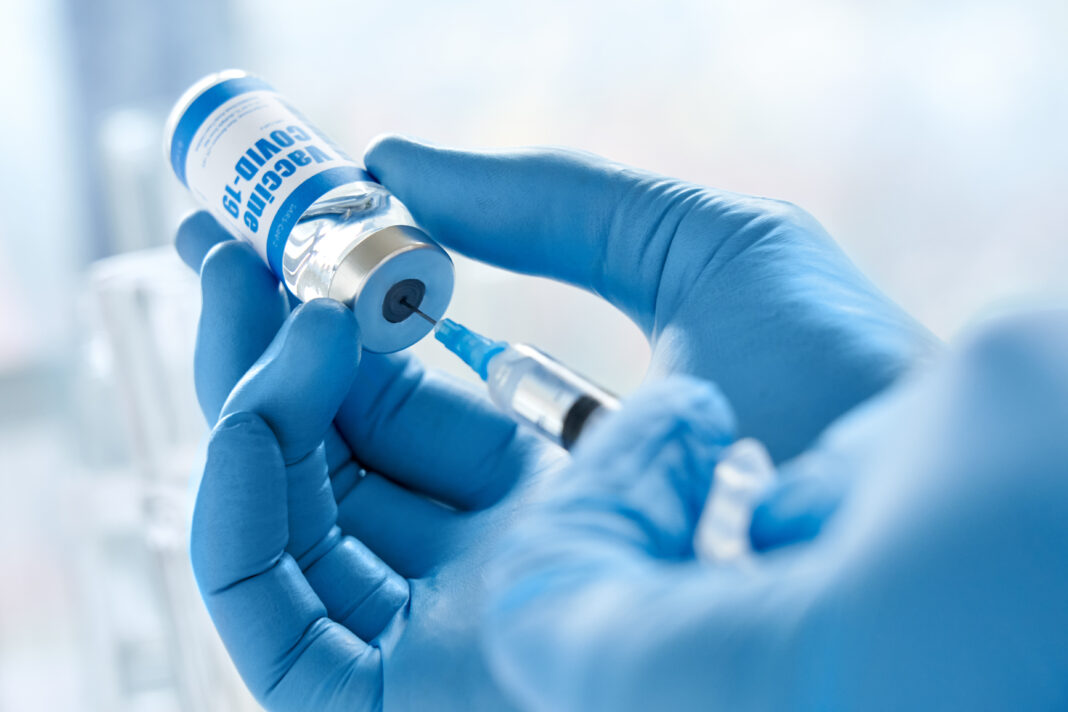In yet another signal that COVID-19 remains a dominant factor in our lives, Dr. Theresa Tam, Canada’s Deputy Chief Public Heath Officer and adviser to the World Health Organization, said on August 12, 2021, that “a fourth wave is under way in Canada.”[1] She reported that active cases in the country have doubled in the last two weeks to 13,000. How does this information fit into what we know about vaccine rates, herd immunity, and the reproductive numbers for COVID-19 and the more transmissible Delta variant? What should Canadians expect as vaccination rates rise? Will vaccination alone eradicate COVID-19?
To address these questions, we will review what we know and present some simple models and predictions regarding vaccination and its potential effect on the spread and control of COVID.
Reproductive number (R0)
In the recent article Understanding vaccine effectiveness and breakthrough, we explained the concept of basic reproduction rate R0. R0 is the initial, basic, or pristine reproductive rate. It defines the disease’s infectious potential, though not its severity. It is the key variable to understand in determining the herd immunity vaccination rate. R0 is the number of secondary infections that are generated from an initial case prior to any element of the population becoming immune and prior to any mitigation strategies.[2]
R0 values greater than 1 represent a disease that is spreading. R0 numbers less than 1 represent a disease that is contracting.
While R0 is also very difficult to estimate and should be treated as highly uncertain, here are some published estimates of key R0 numbers:[3] [4]
- Original or Wild COVID: 2.87 (2.39 to 3.34)
- The Alpha variant: 4 to 5
- The Delta variant: 5 to 9.5
Effective reproductive number (Re)
As individuals in a population become immune through surviving the disease or through vaccination, R0 becomes irrelevant. The time variant or effective reproduction number (Re) is more appropriate. Re is always less than R0 because there are fewer susceptible people to infect. While Re can be lowered through non-pharmaceutical interventions (lockdowns and/or restrictions), we will concern ourselves with how vaccination affects Re. [5]
What are the assumptions regarding vaccination as a control for the disease?
The following formula has been presented in the previous article as defining the “herd immunity vaccination rate”:
 And given the R0 values presented above for different COVID strains, we show the chart below illustrating the range of vaccination rates required to achieve herd immunity for each COVID variant:[6]
And given the R0 values presented above for different COVID strains, we show the chart below illustrating the range of vaccination rates required to achieve herd immunity for each COVID variant:[6]
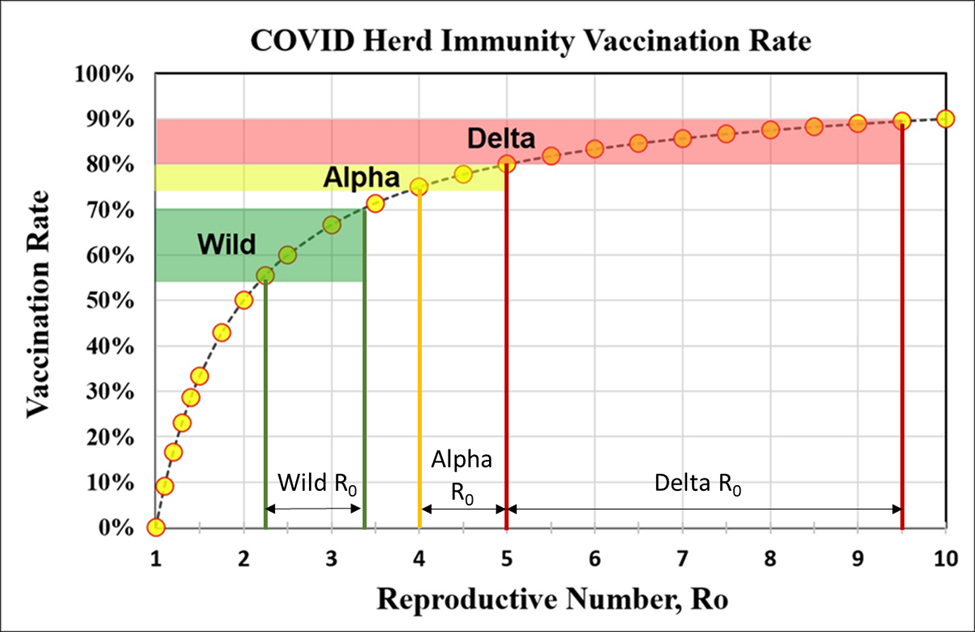
Chart showing the relationship between the R0 of various COVID variants and the herd immunity vaccination rate, using the new R0 range from the July 29, 2021, CDC report for the Delta variant. The Delta variant could require vaccination rates as high as 89.5% to reach herd immunity.
The model we have presented assumes that vaccination is completely effective in halting the transmission of the disease and that the population has a homogenous uptake and response to the vaccination. Given these assumptions, this chart must be viewed as a simplistic, best-case scenario.
To date, Canada’s single-dose vaccination coverage is 71%. Canada’s complete (two-dose) vaccination coverage is 60%.[7]
What can we predict with only this information?
Under these assumptions of 60% full-dose coverage and 71% partial vaccination coverage, and a complete halting of transmission of the disease, Canada would be in the range, or about to enter the range for controlling and reducing COVID-19 from vaccination alone, only if we were to consider just the original Wild strain.
If the Delta or Alpha variants are considered, a fourth wave will occur unless, according to the simplistic modelling presented, the two-dose vaccination rate increases above 80% or strong restrictions are enacted.
How is Re affected by vaccination rates?
In the absence of any restrictions, and assuming that vaccination completely halts transmission in a homogeneous population, the relationship between vaccination rate (V) and Re is:
Re = Ro x (1 – V) [8]
This is intuitively clear, given that vaccination is assumed to remove a percentage of the population from the pool of potential infectees.
The chart below explores this relationship for the original strain of COVID and the Delta variant.

Chart showing the effective reproductive numbers (Re) for the original COVID-19 strain and the range of Delta variant cases given a particular vaccination rate. This chart is as optimistic and simple as possible. It assumes a homogenous population for vaccinations and that the vaccines are 100% effective and stop all transmission.
Note that Re is only predicted to be near or below a value of 1 for the original COVID strain.
Predictions for Re could be made using this relationship for various jurisdictions within Canada.[9] This is given in the chart below:
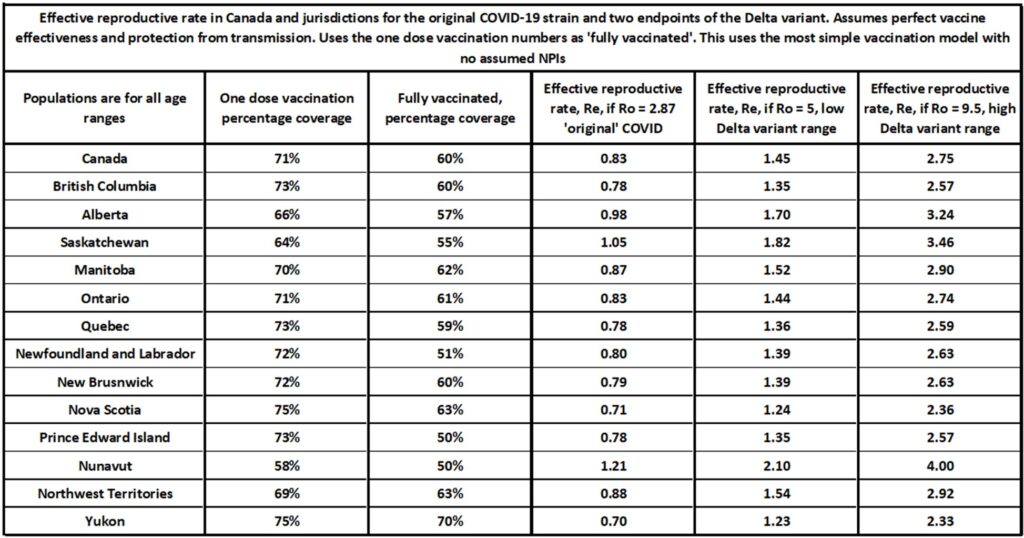
Table showing vaccination rates in Canadian jurisdictions, inferred effective reproductive rates (Re) due to vaccination for the original COVID-19 strain, and the high and low original reproductive rate ranges for the Delta variant. This table is optimistic as it uses one-dose percentages for the Re calculations. Vaccination data from the Government of Canada, August 6, 2021.[10]
What if immunity is imperfect?
The original Pfizer Phase III trial showed 95% effectiveness against symptomatic disease of the original strain of COVID. [11]In the recent BIG Media article Understanding vaccine effectiveness and breakthrough we reported that vaccine effectiveness is lower for the Delta variant and that even the vaccinated may transmit the Delta variant.
In both England/Scotland and Canada, the two-dose Pfizer vaccine conferred 88% and 87% vaccine efficiency against the Delta variant for symptomatic disease. In Israel, these numbers were lower (64%) for confirmed infections. Vaccine effectiveness against hospitalization and death was 96% in England/Scotland, 100% in Canada, and 93% in Israel.
These vaccine effectiveness numbers against the Delta variant suggest that most vaccinated people should be well protected against severe outcomes. However, the lower effectiveness against symptomatic disease and confirmed infections suggest that transmission of Delta is happening to some degree despite vaccination.
Up to this point, we have not considered imperfect vaccine effectiveness in our modeling of herd immunity. How can we account for the effectiveness of the vaccine against transmission in our understanding of vaccination-derived immunity?
To address this, we define a term E, which is the vaccine effectiveness against transmission. This term is similar (but not always exactly the same) to vaccine effectiveness in that it is “the reduction in transmission to and from vaccinated individuals compared with unvaccinated individuals”.[12]
Considering E, our modified formula for the herd immunity vaccination rate becomes:
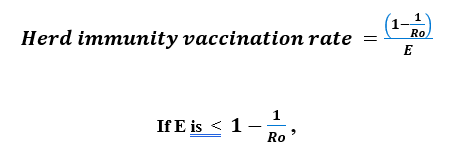
Then the herd immunity vaccination rate, which is the answer to the equation, is greater than 100% of the population, which is impossible. That would mean it is impossible to eradicate the disease.[13]
Effect of imperfect immunity on herd immunity vaccination rates
Given that the Delta variant requires a vaccination rate between 80% and 89.5%, the vaccine effectiveness against transmission (E) needs to be at least that high. E may or may not be that high. Given the data reported above about the symptomatic, non-severe outcomes for Delta variant, such high values for E are suspect.
We can use this concept in a more sophisticated chart for the COVID herd immunity vaccination rate (see below). Since we cannot pinpoint the vaccine effectiveness against transmission, and expect it to vary by strain, we represent several possibilities for E.
We use 100%, 95%, 90%, 85%, 80%, and 65%, a range justified by the Pfizer Phase III trial (E=95%) and the data reported by Israel (E=64%)
Note that for Wild COVID, it appears that herd immunity is achievable down to 65% effectiveness against transmission. For the Delta strain, even the lowest ranges for its potential R0 require at least 80% effectiveness against transmissibility in order for it to even be possible to reach herd immunity and eradicate the strain.
This does not imply that vaccination is without use; the Pfizer vaccine shows high effectiveness against severe outcomes of the disease. In addition to protecting most of the vaccinated against severe outcomes, the Re values will still be lowered, which is a positive indicator for health care systems.
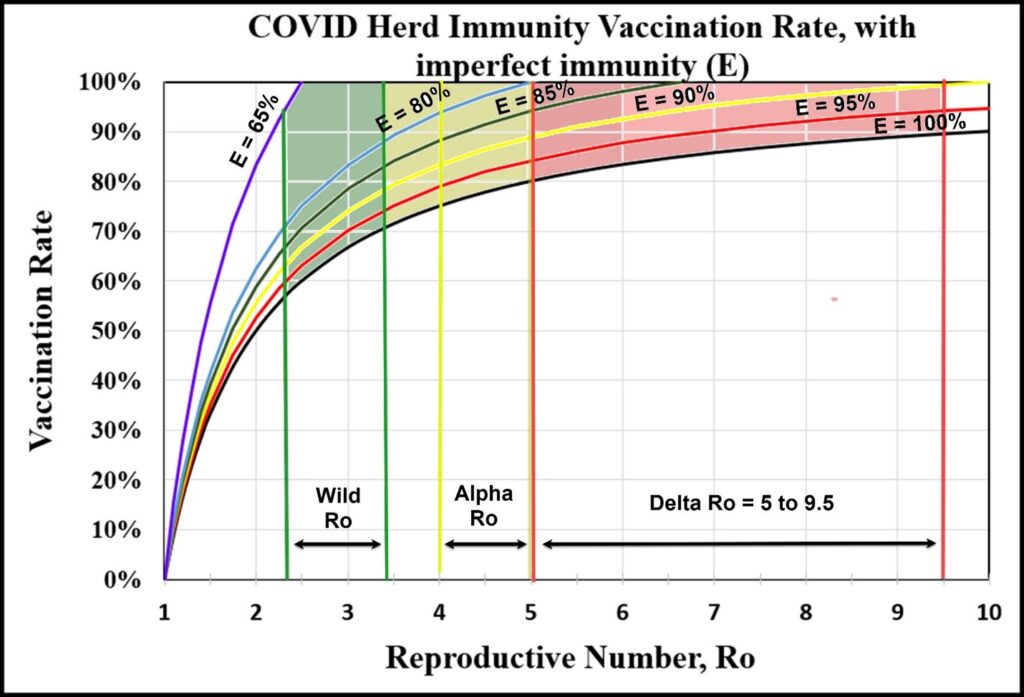
Chart showing the herd immunity vaccination rate prediction for various strains of COVID, but this time accounting for imperfect immunity. Each line represents the calculation of the herd immunity vaccination rate using a different value for, E, or the vaccine effectiveness against transmission. E= 100% coincides with the old curve that was used when the herd immunity rate assumed perfect vaccination effectiveness to transmission. When the curves intersect the 100% “vaccination rate” line on the y-axis, the scenario is considered impossible to eliminate or eradicate the strain.
Interpretation
Even under simple, optimistic models, Canada’s current vaccination levels will not prevent a fourth wave of COVID-19 driven by the Delta variant.
Models that consider the fact that vaccines are not perfectly effective against transmission suggest that it is potentially impossible to eradicate the Delta variant of COVID with the current vaccines and a 100% vaccination rate.
This does not suggest that Canada should necessarily be locked down indefinitely. If COVID cannot be eradicated through vaccination, we must decide how to manage our future. The disease may persist but its severe effects might be mitigated through vaccination.
References
[1] D’Andrea, Aaron, August 12, 2021, Fourth wave of COVID-19 now underway in Canada, Dr. Theresa Tam says, Global News
[2] Hunt, Lee, July 27, 2021, Examining the effectiveness of restrictions and the path to COVID eradication, Big-Media
[3] Hunt, Lee, July 27, 2021, Examining the effectiveness of restrictions and the path to COVID eradication, Big-Media
[4] Hunt, Lee, August 3, 2021, Understanding vaccine effectiveness and breakthrough, Big Media
[5] You Li, Harry Campbell, Durga Kulkarni, Alice Harpur, Madhurima Nundy, Xin Wang, et al, 2020, The temporal association and lifting non-pharmaceutical interventions with the time-varying reproduction number ® of SARS-CoV02: A modelling study across 131 countries: The Lancet Infectious Diseases, Vol. 21, No. 2. P193-2020
[6] Hunt, Lee, August 3, 2021, Understanding vaccine effectiveness and breakthrough, Big Media
[7] Government of Canada, COVID-19 vaccination in Canada, August 6, 2021
[8] Aronson, Jeffrey, Jon Brassey, Kamal Mahtani, 2020, “When will it be over?”: An Introduction to viral reproduction numbers, Ro and Re, CEBM Research, University of Oxford
[9] Government of Canada, COVID-19 vaccination in Canada, August 6, 2021
[10] Government of Canada, COVID-19 vaccination in Canada, August 6, 2021
[11] Hunt, Lee, August 3, 2021, Understanding vaccine effectiveness and breakthrough, Big Media
[12] Fine, Paul, Ken Eames, David Heymann, 2011, “Herd Immunity”: A Rough Guide, Clinical Infectious Diseases, 2011: 52 (7) 911-916
[13] Fine, Paul, Ken Eames, David Heymann, 2011, “Herd Immunity”: A Rough Guide, Clinical Infectious Diseases, 2011: 52 (7) 911-916
(Lee Hunt – BIG Media Ltd., 2021)
